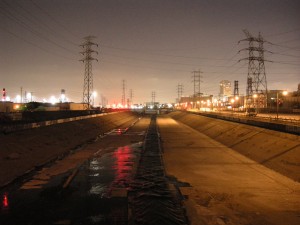“Generative Monologue” a Main Street Song by Jason Cady
By Mapping Main StreetKara and I had collaborated with composer Jason Cady on the sound installation “Chorus of Refuge” where he pitch shifted and combined the voices of six refuges into one choral work (for six radios). We loved it and wanted to work with him again. We found out his father lived off of a Main Street near his hometown of Flint, Michigan. His father worked on the assembly lines at General Motors.
Below, Cady describes how he took the three-hour oral history of his father and transformed it into ‘Generative Monologue.”
Generative Monologue
I composed Generative Monologue for spoken voice, synthesizer, and field recordings.
1. The Voice:
My father, Dennis Cady, is a retired autoworker. He was born and raised in Flint, Michigan. He now lives on a street that turns into Main Street.
My father was born during World War II and his father died fighting in the Normandy invasion. His mother worked evenings and he was left alone to raise himself. Even before reaching adolescence he had already taken up smoking, drinking, shoplifting and hitchhiking.
His older sister was expelled from all the high schools in the area and eventually dropped out. My father, however, graduated from high school and attended Mott Community College while working at a gas station. His mother pressured him to withdraw from college so that he could work full time at one of the General Motors factories. So he applied for a job at Buick and was hired to work at a complex of factories called Buick City.
My father met my mother at Buick City where they worked along side each other on the assembly line. After they married she encouraged him to quit drinking, which he did. Years later he used subliminal tapes to quit smoking.
For the last ten years before my father retired he worked eighty hours a week. He won accolades and an award from Buick for the hard work and the long duration and consistency of his overtime.
After retiring he was diagnosed with cancer. He believes that it may have been caused by some of the chemicals that he was exposed to at his job. It has been four years since his last surgery and he is still recovering from the chemotherapy.
My father’s recollections and reflections on his life are the content of Generative Monologue. I chose to create this piece with his voice, not only because he is an engaging storyteller, but also because of the timbre, melody, and expressiveness of his bass voice.
2. The Music:
Generative Monologue begins in D minor, modulates to A minor and ends in D minor with the same basic material occurring in both the tonic and then transposed to the dominant. The harmonic progression that repeats and forms the core of the piece is:
D- Bb D-
A Bb dim A
A dim C7 A dim
B-7 G- A
This chord progression supports a mostly two-note melody of the pitches A and Bb, while the other notes of the harmonies descend chromatically by parallel minor thirds. I composed this melody and chord progression to fit the basic character of the story.
I performed the melody and chords on synthesizer. The voice “solos” on top of the synthesizer part with continuously changing material. I used pitch correction software to tune and quantize the voice. After tuning the voice to the chromatic scale I then adjusted the notes to fit with the harmonies. I always tried to manipulate the voice as little as possible to avoid digital artifacts from the software; usually I would just move the notes up or down a half step. In spite of that, the voice still came out sounding strange at various moments, though the oddness does, of course, contribute to the overall character of the piece.
I used pitch correction software on speaking voice previously for a sound installation — Chorus of Refuge — that I composed in collaboration with Ann Heppermann and Kara Oehler. In Chorus of Refuge there were six a cappella voices transmitted through radios simultaneously. For Generative Monologue I worked with the same process while focusing on only one voice, with instrumental and other sounds, for a homophonic texture instead of the polyphony of Chorus of Refuge.
3. The Background:
Along with the foreground voice and synthesizer I also included backing vocals and ambient tracks. The backing vocals are comprised of additional tape from interviews with my father. The ambient tracks are field recordings of the Flint River that were recorded behind my father’s house, which runs through Flint and along Main Street. I put all the background tracks through a vocoder using the same chords as the synthesizer tracks. This background layer enriches the texture by providing some more irregular sounds in contrast to the repetition and synthetic perfection of the foreground.
Recorded and mixed by Clay Holley, interviews and field recordings by Ann Heppermann

















